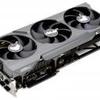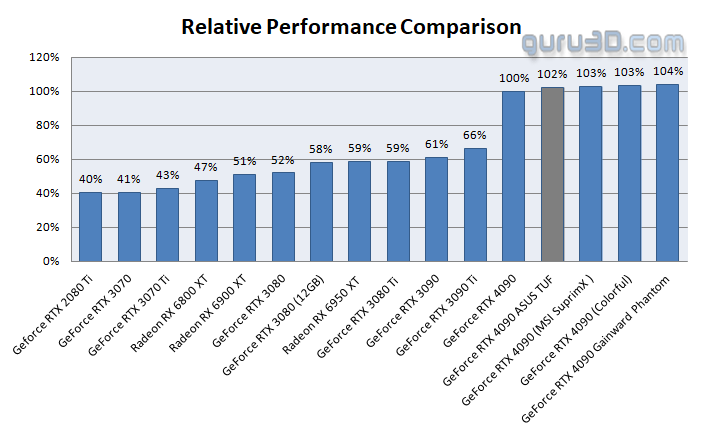Final words and conclusion
Final words
At the time of writing this article, it looks like the TUF edition will cost just as much as the NVIDIA MSRP, and granted that has a lot going for it. You'll gain ~2% in performance overall (measured from that founder edition); however, get a few more options in relation tho BIOS choices. It is however bulky card to look at, but a very lovely card overall. From a raw shader point of view, this product offers a very lovely performance improvement over the last gen, we also can note down the massive increase in raytracing performance and added raytracing features of course. This round NVIDIA is betting big on DLSS though, with vastly improved Tensor cores that assist the new DLSS 3.0, currently quickly offering a 2x performance increase. With proper implementation of future games, NVIDIA claimed seven a 3x or 4x increase in performance, these are staggering values. NVIDIA needs to fight two things though, the first one is pricing. Starting at $1599, but more likely ending in a 2000 EUR range these cards have become a product in a realm that hardly even is reachable anymore. Next to that a TBP of 450 Watt in times when energy prices have doubled/tripled doesn't exactly set the bar or even a good example of a company caring about the environment and cost to play; just sayin' of course. Trust me; it's a freakfest of performance, but granted, also bitter-sweet when weighing these factors in.
Performance
Right, I spilled the beans already in the previous paragraph, but ultimately it is all about that, gaming performance, and, of course, rendering quality. Of course, the GeForce RTX 4090 is a product that does not need to make sense and cannot disappoint in that department, albeit we feel the RTX 4080 likely offers more value for money. We're nearing raw performance numbers that enable gaming at an 8K resolution; we can not check this for ourselves, nor do we find this relevant as most enthusiast gamers game at monitor resolutions of UWHD, QHD or UHD. You will often run into bottlenecks and CPU limits with a card like this at Full HD. But even there, some games with good programming and the right API (DX12/ASYNC computation) reveal a good performance boost.
The old rasterizer engine breaks right through the limit for extreme performance. Because of the 16K Shading processors, all of this is possible. The RTX 40 series now has a new generation of Ray tracing and Tensor cores that are more powerful. So, do not let the specific RT and Tensor core counts fool you; it's all about how much performance one unit offers. Since they are close to the engine that does the rendering, they have become more efficient, which shows. Tensor cores are harder to measure, but from what we have seen, everything seems to be in good shape as DLSS3 shows breathtaking values. Overall, the GeForce RTX 4090 makes sense at resolutions as low as 2K 2560x1440,up-to 4K (3840x2160). As is usually the case when comparing apples and oranges, different architectures have different performance statistics because each architecture has its strengths and weaknesses in certain game render workloads.
Cooling & noise levels
The cooling design is fantastic. While being an enthusiast-class product with brutally high power consumption, we measure this to be ~440 Watts under full load. That Wattage directly relates to the amount of heat produced by the GPU, which sits inside a closed chassis. We hit 34 dBA in highly stressed conditions at quiet bios mode (default), though it took a while for the card to get there (warms up slowly), but even that is considered an average acoustic level. Under heavy load conditions, expect the card to pass 70c; depending on the airflow inside your chassis (depending on the airflow in your chassis) that value can rise. FLIR imaging shows nothing worrying. Alternatively, you can select the performance BIOS which makes acoustic rise to 38~39 DBa and temps down to 65 Degrees C. We say leave it at quiet.
Energy
We touched the topic a bit already; the power draw under intensive gaming for GeForce RTX 4090 is significant, especially in a time where energy prices are soaring; this product isn't a good example. We measured it to be close to the 435 Watt range. This is the tradeoff for a bit more bite in performance for this graphics card model in particular. Gaming wise that number will fluctuate a bit—Board partner cards to show higher numbers as they get more TGP allowance. You'll also get a little extra reserve to tweak of course.
Coil whine
Much like the 3090, the GeForce RTX 4090 does exhibit coil squeal. Is it annoying? It's at a level you can hear it. In a closed chassis, that noise would fade away in the background. However, with an open chassis, you can hear coil whine/squeal. Graphics cards all make this in some sort or form, especially at high framerates this can be perceived. We heard a little more coil whine compared to the founders edition and the Suprim X though.
Pricing
The reference/founder edition GeForce RTX 4090 from NVIDIA costs USD 1599; for most of us too much for something you can use to play PC games with. This product is tagged at 1599 USD, that's quite okay compared to that founder edition if you ask me. It's still an absurd amount of money of course for something to play games with.
Tweaking
ADA AIB card certainly can be tweaked, passing even 3 GHz on the GPU. it doesn't get you a lot more performance ance though. The GPU constantly hits the power limiter at defaults, so that's your first and quickest option to tweak. You get extra perf on the card's default power budget. The clock frequency can take a good +200 MHz extra. Apply it, and you'll see the GPU boost clock hovering in the ~3000MHz domain (frequencies vary per game title as they are dynamic). The power limiter could be increased by 33% (!) but in the end that increased the TGP towards a measured 505 Watts for almost no extra performance so be careful with that. The memory could be tweaked to 22 Gbps, so all these are terrific values bringing ~5% additional performance on challenging GPU situations, measured from founder edition level performance, and 3% coming from this card's default performance.
Conclusion
It is an excellent product in terms of gaming performance and graphics quality. My biggest concerns are not with performance but with cooling as it is just so BIG. This card consumes close to 435 Watts of power. You must be gaming at an Ultra HD resolution or higher to make sense of this card. Regardless of my disdain for price and energy waste, I do enjoy a decent piece of hardware inside a PC, except for the required NVIDIA-designed adaptor, which transforms four 8-pin PCIe power connectors into a 12+4 pin 12VHPWR. Three DisplayPort and one HDMI are available as video outputs. A sleek, three-dimensional backplate with a brushed aluminium finish is included. A dual-BIOS switch is located close to the power jack. ADA GPU architecture can perform skillfully and excellently; the GeForce RTX 4090 is a powerhouse. A good chunk of extra shader cores, nearly double performance Raytracing and Tensor cores, and underlying technologies like Shader Execution Reordering (SER) and DLSS 3.0 make the new product and Series 4000 shine. The GeForce RTX 4090 AD102 GPU has 76.3B transistors; I mean, OMG, staggering values. Starting at $1599; yes, the price is an unfavourable factor, and the amount of energy used as explained, is also something to ponder about. Both are high for this product to make any sense. For this graphics card to make any sense, you must play games in Ultra HD or at least start at a monitor resolution of 2560x1440. We also know that because the product is in a very narrow niche, the two negatives do not have to make sense to a lot of you as enthusiast components are a class of their own. Regardless of it all, I live and thrive on exciting technology; I like this piece of hardware inside a PC, though, because it is a magnificent product no matter how you look at it.
The RTX 4090 will exhaust a lot of heat, so ensure you have a lot of ventilation. The card is big and heavy (2.3kg), but still looks great, but you need to make sure you can fit this inside your PC. The performance, man, that performance, it is all good. Take Flight Simulator 2020 combined with DLSS 3.0, you can fly at 100+ FPS in a higher resolution now. Cyberpunk at UHD with raytracing and DLSS easily passes 100 FPS. This is an Ultra HD card, and it shines in that area, whether shading (regularly rendered games) or hybrid ray-tracing + DLSS is used. It is a purebred stallion but needs a lot of power and will only cater to a small group of people. Should you buy this product? Well, from a more economical point of view, you would be better off with a to-be-released GeForce RTX 4070 or 4080. As conclusion we can say that ASUS did it right with the new TUF Gaming OC; yet, the default extra performance is only 2, maybe 3%; however, if you are genuinely into silent operation and stunning appearance, then we can recommend this card above the founder edition at roughly the same price.
- Download NVIDIA GeForce drivers
- Sign up to receive a notification when we publish a new article.
- Or go back to Guru3D's front page
- Hilbert, LOAD"*",8,1.



